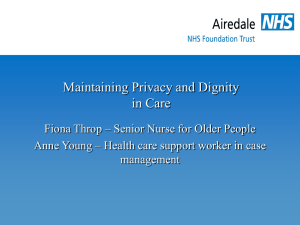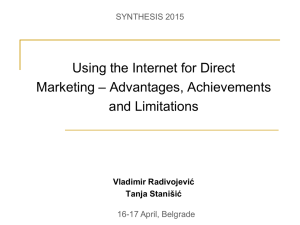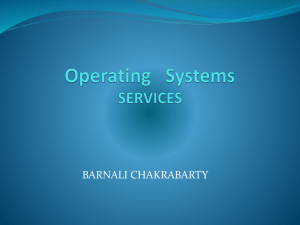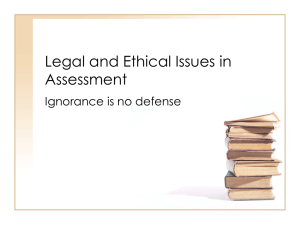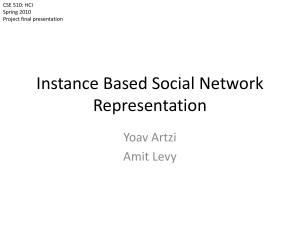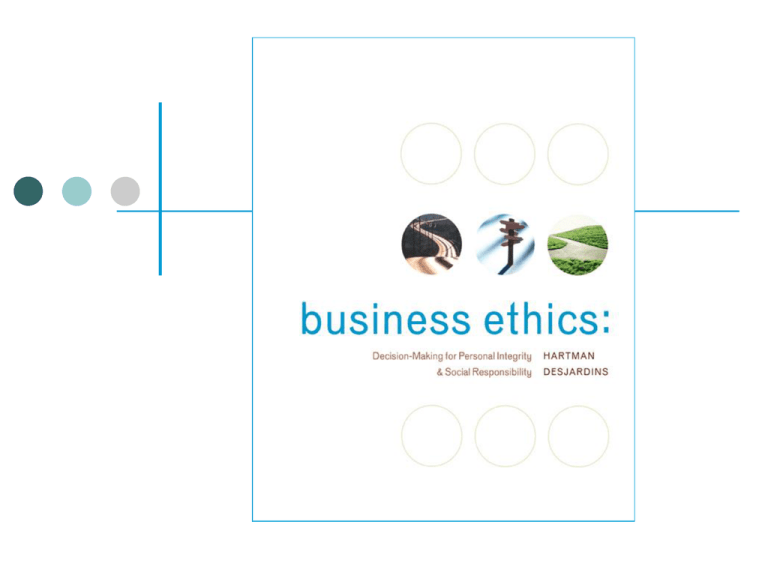
Chapter
7
Ethical Decision-Making:
Technology and Privacy
in the Workplace
McGraw-Hill/Irwin
Business Ethics: Decision-Making for Personal Integrity
& Social Responsibility
Copyright © 2008
7-2
1-2
The McGraw-Hill Companies, Inc. All rights reserved.
Chapter Objectives
After exploring this chapter, you will be able to:
1.
2.
3.
4.
5.
Explain and distinguish the two definitions of privacy.
Describe the ethical sources of privacy as a fundamental value.
Identify the three legal sources of privacy protection.
Discuss the concept of a “reasonable expectation of privacy”
Discuss recent developments in connection with employee
monitoring
6. Explain the risks involved in a failure to understand the
implications of technology and its use.
7. Identify additional ethical challenges posed by technology use.
7-3
1-3
Chapter Objectives
8. Articulate the manner in which employee monitoring works.
9. Enumerate the reasons why employers choose to monitor
employees’ work.
10. Explain why monitoring might also pose some costs for the
employer and for the employee.
11. Discuss the elements of a monitoring program that might balance
the interests of the employee and the employer.
12. Discuss the ethics of monitoring as it applies to drug testing.
13. Discuss the ethics of monitoring as it applies to polygraphs,
genetic testing and other forms of surveillance.
14. Explain the interests of an employer in regulating an employee’s
activities outside of work.
7-4
1-4
What is Privacy?
Two general and connected understandings of
privacy can be found in the legal and philosophical
literature on this topic:
Privacy as a right to be “let alone” within a
personal zone of solitude, and
Privacy as the right to control information
about oneself.
7-5
1-5
The Value of Privacy
Privacy is important because it serves to establish the
boundary between individuals and thereby serves to define
one’s individuality.
The right to control certain extremely personal decisions and
information help determine the kind of person we are and the
person we become.
To the degree that we value the inherent dignity of each
individual and treating each person with respect, we must
recognize that certain personal decisions and information is
rightfully the exclusive domain of the individual.
7-6
1-6
Ethical Sources of a Right to
Privacy:
Privacy as a Universal Right
The right to privacy is founded in the individual’s
fundamental, universal right to autonomy, in our right to
make decisions about our personal existence without
restriction.
This right is restricted by a social contract in our culture that
prevents use from infringing on someone else’s right to her or
his personal autonomy.
7-7
1-7
Additional Ethical Sources of
Privacy Rights
Hypernorms: An approach to ethical analysis that seeks to
differentiate between those values that are fundamental across
culture and theory ("hypernorms") and those values which are
determined within “moral free space" and which are not
hypernorms.
Property rights: Property rights relating to personal
information define actions that individuals can take in relation
to other individuals regarding their personal information. If
one individual has a right to her or his personal information,
someone else has a equivalent duty to observe that right.
7-8
1-8
Legal Sources of a
Right to Privacy
There are three ways in which privacy may be legally
protected:
By the Constitution (federal or state),
By federal and/or state statutes, and
By the Common Law.
7-9
1-9
Common Law Protections
(case law)
The “invasion of privacy” claim with which most people are
familiar is one that developed through case law called
“intrusion into seclusion.”
This legal violation occurs when someone intentionally
intrudes on the private affairs of another when the intrusion
would be “highly offensive to a reasonable person.”
7-10
1-10
What is “Reasonable” (as in a
“reasonable expectation of privacy”)
Most recent court decisions with regard to monitoring
specifically seem to depend on whether the worker had notice
that the monitoring might occur.
Since the basis for finding an invasion of privacy is often the
employee’s legitimate and reasonable expectation of
privacy, if an employee has actual notice, then there truly is
no real expectation of privacy.
7-11
1-11
Managing Employees through
Monitoring
One of the most prevalent forms of information gathering in the
workplace, in particular, is through monitoring employees’ work, and
technology has afforded employers enormous abilities to do so
effectively at very low costs.
The American Management Association has conducted surveys of
mid- to large-sized U.S. firms over the past few years that show an
increasing trend with regard to email monitoring of employees.
While its 2003 survey reported that 52% of firms monitored email
communications, up from 47% in 2001, its 2005 survey reported that
55% engaged in monitoring.
The 2005 survey also found that 42% of these firms have a policy that
covers instant messages use of its employees.
7-12
1-12
Risks Involved in Failure to
Understand Technology
Unfortunately, many of the ethical issues that arise in the area of
managing information are not readily visible.
When we do not understand technology, we are not able
effectively to protect our own information because we may not
understand the impact on our autonomy, the control of our
information, our reciprocal obligations, or even what might be
best for our personal existence.
These ethical issues may be compounded by the fact that there
exists a knowledge gap between people who do understand the
technology, and others who are unable to protect themselves
precisely because they do not understand.
7-13
1-13
Ethical Challenges Posed by
Technology Use
Technology allows for access to information that was never before
possible.
Under previous circumstances, one could usually tell if someone had
steamed open a letter over a teapot. Today, you usually cannot discover
if someone reads the email you sent to your best friend yesterday.
Access can take place unintentionally, as well. In doing a routine
background check, a supervisor may unintentionally uncover information
of an extremely personal nature that may bear absolutely no relevance to
one’s work performance.
This occurs because the information, though previously unavailable or
too burdensome to uncover, is now freely available from a variety of
sources.
7-14
1-14
Why do firms monitor
technology usage?
Employers need to manage their workplaces in order to place workers in
appropriate positions, to ensure compliance with affirmative action
requirements, or to administer workplace benefits.
Monitoring also allows the manager to ensure effective, productive
performance by preventing the loss of productivity to inappropriate
technology use.
Monitoring offers an employer a method by which to protect its others
resources. Employers use monitoring to protect proprietary information
and to guard against theft, to protect their investment in equipment and
bandwidth; to protect against legal liability.
7-15
1-15
Business Reasons to
Limit Monitoring
Monitoring may create a suspicious and hostile workplace.
Monitoring may arguably constrain effective performance since it can
cause increased stress and pressure, negatively impacting performance
and having the potential to cause physical disorders such as carpal tunnel
syndrome.
Stress might also result from a situation where workers do not have the
opportunity to review and correct misinformation in the data collected.
These elements will lead not only to an unhappy, disgruntled worker who
perhaps will seek alternative employment but to lower productivity and
performance that will reap higher costs and fewer returns to the
employer.
Finally, employees claim that monitoring is an inherent invasion of
privacy in violation of their fundamental human right to privacy.
7-16
1-16
What would a “Balanced”
Monitoring Program Look Like?
A monitoring program developed according to the mission of the
organization (e.g. with integrity), then implemented in a manner that
remains accountable to the impacted employees, approaches that balance.
No monitoring in private areas (e.g. restrooms)
Monitoring limited to within the workplace
Employees should have access to information gathered through
monitoring
No secret monitoring - advance notice required
Monitoring should only result in attainment of some business interest
Employer may only collect job-related information
Agreement regarding disclosure of information gained through
monitoring
Prohibition of discrimination by employers based on off-work activities
7-17
1-17
Monitoring Employees
through Drug Testing
With regard to drug or other substance testing, the employer
has a strong argument in favor of testing based on the law.
Since the employer is often responsible for legal violations of
its employees committed in the course of their job, the
employer's interest in retaining control over every aspect of
the work environment increases.
On the other hand, employees may argue that their drug usage
is only relevant if it impacts their job performance.
Until it does, the employer should have no basis for testing.
7-18
1-18
Other Forms of Monitoring
Employers are limited in their collection of information
through other various forms of testing, such as polygraphs or
medical tests
Employers are constrained by a business necessity and
relatedness standard or, in the case of polygraphs, by a
requirement of reasonable suspicion.
7-19
1-19
Regulation of Off-Work Acts
The regulation of an employee’s activities when she or he is
away from work is an interesting one, particularly in at-will
environments.
However, even employers of at-will employees must comply
with a variety of statutes in imposing requirements and
managing employees.
7-20
1-20
Chapter Seven Vocabulary Terms
After examining this Chapter, you should have a clear understanding of the following
Key Terms and you will find them defined in the Glossary:
Electronic Communications Privacy Act of 1986
Email monitoring
European Union Directive on Personal Data Protection
Fourth Amendment protections
HIPAA
Hypernorms
Internet Use Monitoring
Intrusion into Seclusion
Moral Free Space
Personal Data
Privacy
Privacy Rights
Property Rights in Information
Reasonable Expectation of Privacy
Reciprocal Obligation
Safe Harbor Exception
Uniting and Strengthening America by Providing Appropriate Tools Required to Intercept
7-21
and Obstruct Terrorism United States (USA PATRIOT) Act of 2001
1-21


